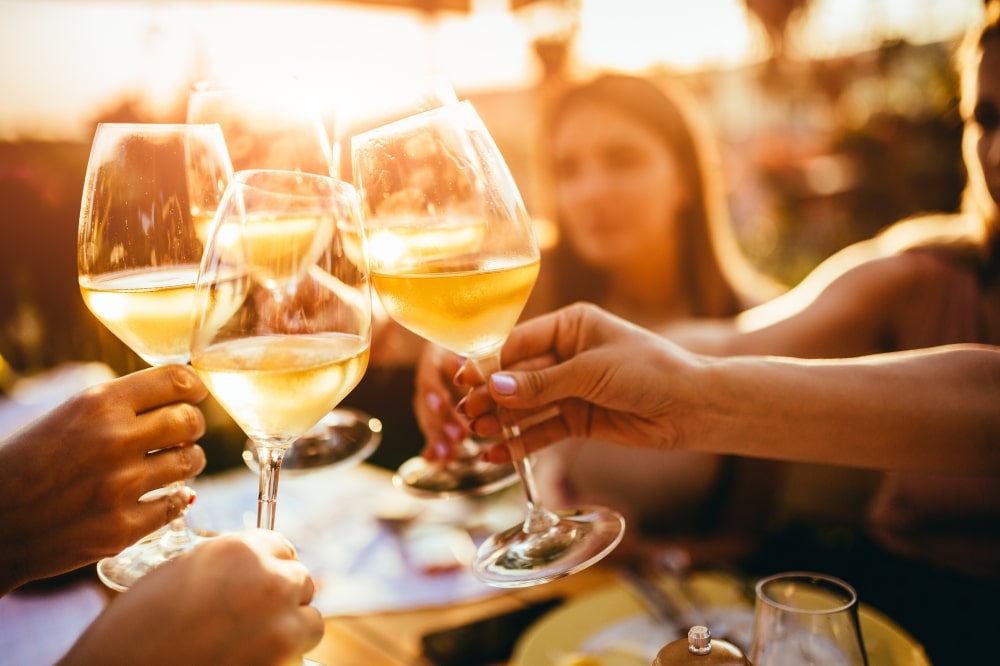When did you last drink Riesling? Much like undervalued sherry, which has curiously modest crowd appeal, Riesling is prized by wine aficionados but is strangely not at all mainstream. Simultaneously powerfully scented and flavoursome whilst exceedingly refined, nuanced, and layered, Riesling (pronounced ‘Reessling,’ not ‘Ry-sling’) – Germany’s signature grape – is also one of the most flexible food wines loved by savvy sommeliers and wine collectors in the know.
Working best solo, it’s one of the most long-lived and versatile whites, producing a range of unoaked wines at diverse sweetness levels from different regions in the wine world. A racy, delicate and aromatic northerner, it stimulates both the palate and feeds the mind.
This week I consider bone-dry versions (nowadays more and more Riesling is not sweet) with characteristically low-medium alcohol and high levels of extract. A cold glass of zesty and juicy Riesling makes a brilliant stand-alone aperitif. Unlike, say, Grenache Noir, late-budding, relatively frost-resistant, cold-hardy Riesling thrives in cool locations where other heat-loving grapes would fail to ripen. It is comparatively late ripening (picking dates vary according to the required sweetness level) and needs dry autumns and good sun exposure.
Whether dry or off-dry, Riesling is astonishing with spicy Thai fare, meshing extraordinarily well with its fruity/sweet-sour/spicy/coconut constituents. Hello (again) Kai’s Kitchen! Try these three zingy summer-sipping bottles, which are chock-full of character…
1. High Street Choice: a dry German Riesling from a 650-year-old, 46-hectare estate with vineyards on the Mosel and both of its small tributaries
Reichsgraf Von Kesselstatt, Schloss Marienlay Dry Riesling, Mosel, Germany 2020 (£12, Co-op, 12%)
Germany’s cool-climate Mosel Valley is home to the planet’s steepest vineyards. Here the sun hits the vines at a perfect ripening angle, enabling winemakers to craft the most supreme and purest expressions of Riesling on gravity-defying, mainly south-facing slaty slopes. With a quarter of its total vineyard area planted to it (by far the biggest in the world), there’s no question Germany can produce world-class dry, medium-sweet and lusciously sweet Rieslings. Indeed, it’s the country’s signature grape – and one of the most ancient, classically geographically expressive (à la Cabernet Sauvignon and Pinot Noir) German grape varieties.
This one’s a crisp, lip-smacking, light-bodied Trocken (dry) Riesling from Reichsgraf von Kesselstatt, a 650-year-old family-run estate based in Trier (Germany’s oldest city, where the Romans planted the first vineyards along the Mosel River) in the heart of Europe where Germany, Luxembourg and France meet. Kesselstatt has major vineyard holdings in the Mosel, Saar and Ruwer valleys. Think peaches, apple blossom, orchard fruits, lime and grapefruit. Light on its feet, appealingly fruity, dry, kinetic, balletic and gastronomic, it has plenty of extract, talcy acidity, and nimble alcohol and feels like it’s made from beams of light. A perfect lunchtime summer swig. Indeed, I needed to bow to its demand and gulped all I had in my mouth. One for spicy Indian, Vietnamese and Thai dishes. Bravo to talented Co-op buyer, Edward Robinson. Prost!
2. A top-notch bone-dry Western Australian Riesling with a distinctive limey twist
Robert Oatley Signature Series Riesling 2020, Great Southern, Western Australia (£11.96-£13.99, WineDirect, Solent Cellar, Fareham Wine Cellar, Cambridge Wine Merchants, Vinvm, 12%)
Australia is well known for its Rieslings, especially those from the fêted high-quality areas of Clare and Eden Valleys to the north of Adelaide in South Australia. They are habitually bone dry, with energizing high acidity and many exhibit aromas of lime. Step up this spot-on Western Australian rendition. It’s my kind of thrilling summer sip from a far-flung cool area at the bottom left corner of Oz with juicy lime rind, freshly squeezed lime juice, tangy clementine, green apple, grapefruit and mandarin flavours, plus a touch of spice, floating on a raft of brisk acidity. A ready-to-rumble bottle made with an eye to early consumption. Pour with smoked salmon, fish and chips, pork belly, summertime seafood and tomato and coriander salads. Exceedingly mouth-watering – be careful not to dribble!
3. A gem of a developing Australian Riesling made by an Aussie Master of Wine from fruit sourced from Clare Valley and Tasmania
Hardys HRB Riesling 2017, Clare Valley & Tasmania, Australia (£20, Harvey Nichols, 12.5%)
Now part of the big Accolade Wines group, Hardys continues to make some of the greatest wines Down Under. Winemaking is overseen by chief winemaker, Nigel Sneyd MW. Beginning to burst into song, this is a cut above and a thrilling example of the ’17 vintage, with marvellous drive and intensity. A reel of energy, uncoiling across a spool of preserved lime, orange blossom, citrus zest, beeswax, lanolin, honeysuckle, light kerosene, kaffir lime marmalade and bath salts. The mouth-filling succulent flavours have outstanding drive, line and scintillating length. Tinkling acidity is another blessing; everything is in place. Its balance is flawless, and so is the price. Furthermore, patience isn’t imperative before cracking the screwcap. Striking Riesling, the tastes lingering in the mouth long after the wine has been swallowed (or ejected at the spittoon – the sting of professional tastings).
Super now, or even better in five years, and who knows how long thereafter. It’s a lovely drinking experience and a tapestry of complexity. Chill it for ceviche, spicy Thai cuisine, sashimi, fish tartare, roast pork, gammon or baked red snapper en papillote with lemongrass/coriander. Top vintage.
6 other world-class dry Riesling producers:
Alsace and Austria also make first-class dry (and occasionally sweet) Rieslings in Europe. Listed by region/country:
- Alsace: Zind-Humbrecht (made by France’s first Master of Wine)
- Australia: Crawford River
- Austria: Franz X Pichler
- Germany: JJ Prüm (via German specialist Howard Ripley Wines)
- New Zealand: Felton Road (owned by Briton Nigel Greening)
- USA: Hermann HJ Wiemer
Tipple tip: is my Riesling dry or sweet?
First look at the alcohol percentage on the label. Broadly speaking, once you go above 12%, Riesling gets drier; under 12%, you’re generally looking at the sweeter end of the spectrum.








